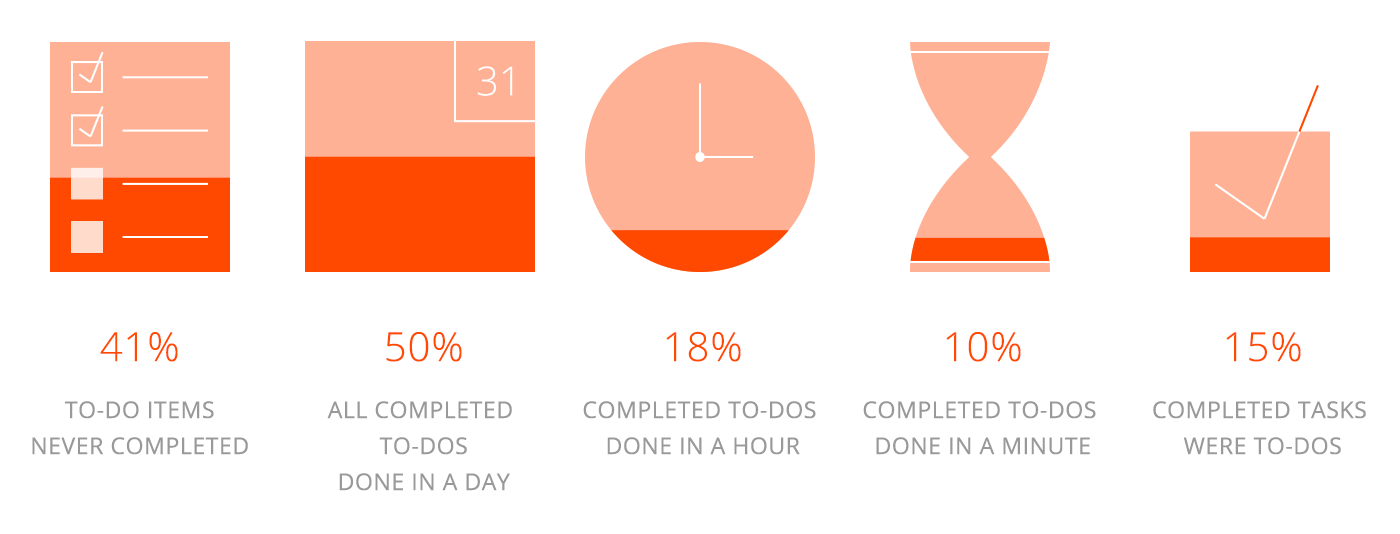This post was adapted from iDoneThis' new ebook, "The Busy Person’s Guide to the Done List".
Whether you're a fervent disciple of the to-do list, or a begrudging list-maker, most of us keep one. Yet, to-do lists always seem to frustrate and overwhelm.
Based on data from our app, iDoneThis, we discovered that:

In other words:
you’ll always have unfinished tasks;
tasks that do get completed are done quickly; and
what you get done often doesn't correlate with what you set out to do.
So is the to-do list just a blunt instrument to wield in the quest to get stuff done? Or are we doing something wrong?
Here are three common problems in how people approach to-do lists:
Problem 1: Too Many To-Do's
First of all, we overload our lists. Social psychologist Roy Baumeister and journalist John Tierney, authors of Willpower: Rediscovering the Greatest Human Strength, report in their book that one person typically has at least 150 different tasks at a time, and that an executive’s to-do list for a single Monday could take more than a week to finish. Sounds like a setup for failure!
What’s more, research by Amy Dalton and Stephen Spiller uncovers how detailed planning works when you have one big to-do item but then, the longer your list of tasks and goals, the less powerful a tool the to-do list becomes.

Overstuffing our lists also causes a persistent thrum of worry in our head, distracting us from tackling the very tasks that are so worrying. Psychologists Robert Emmons and Laura King discovered that the anxiety that results from having too many conflicting goals causes our productivity as well as our physical and mental health to suffer.
So the to-do list gives and takes. It helps us remember the many things we have to tackle. At the same time, it’s a nagging tool that can induce unhealthy, disarming anxiety.
Problem 2: Our Brain Wants Us to Make a Plan
When uncompleted tasks and unmet goals hang out in your brain, distracting and badgering you, that’s the Zeigarnik effect in action. You'd think that the logical response to "cure" the Zeigarnik effect to stop the nagging would be to finish what you set out to do. However, Baumeister and E.J. Masicampo found that the Zeigarnik effect is your unconscious "asking the conscious mind to make a plan" rather than to do the tasks.
Zeigarnik Effect: the psychological tendency to remember an uncompleted task rather than a completed one. - Merriam-Webster
In one of their experiments, they instructed one group of students to think about an important final exam and told another group to create a specific study plan with details like what they would do, where, and when. Afterwards, when given word fragments to complete, the students who'd been told merely to think about the upcoming test filled in exam-related words while the study-plan group did not.
Though the planners had put more effort into thinking about their task without even making any actual progress on the task itself, as Baumeister and Tierney explain, "their minds had apparently been cleared by the act of writing down a plan." Instead of mulling nervously over a test, they had a blueprint to move forward and a clear head.
When our to-do lists grow long, it becomes impossible to plan out everything. And when we fail to think through steps and plans, we don’t get stuff done.
Problem 3: The Future is Full of Unknowns, Interruptions, and Change
Only 15% of iDoneThis members’ dones started out as to-do tasks. You manage to get through the day, working the whole time, but fail to get to most of the tasks on your list.
Your dones won’t match up with to-do’s if you’re not great at formulating well-planned to-do tasks to begin with. When you don't outline specific actions for your goals but do take some forward steps, that progress won’t correlate with the original task. You can’t sort of check or cross off a task as complete.
We also can’t predict the many interruptions that happen in our day. One LinkedIn survey reported that the most common reason for failure to get through a to-do list was unplanned tasks such as unscheduled calls, e-mails, and meetings. Things pop up in our lives, in and out of the office, little and big fires to be put out.
The to-do list can’t handle the changes that crop up because we can’t tell the future.
Turn Your Productivity Around With a Done List
While to-do lists are useful for task organization, they’re certainly not the magical solution to our many productivity problems. Otherwise why do we get so discouraged about how much we’re getting done?
Instead, turn to the done list. Simply, writing down what you accomplish provides boosts of motivation and insight that balances out the to-do list's problems and shortcomings. The lift you get from seeing a visible record of accomplishment pushes you to tackle what’s next while failing to recognize how much you actually do makes it easy to lose perspective, succumb to feelings of failure and guilt, and burn out.

Making a done list is easy:
When you do anything you consider useful, however small a step it may be, write it down on your done list.
At the end of the day, look at your list. Reflect on and celebrate all the things you got done!
Review regularly — whether in the mornings to kickstart your day, every week, month, or year, and simply whenever you need a dose of perspective.
So why does this work? The done list flips your mindset by giving you full credit, capturing everything that came up during the day, including what wasn’t preordained by your to-do list or initial plans. Taking a moment to stop and appreciate the roses of your efforts offers powerful encouragement.
Without these pauses, you lose opportunities to gain boosts of motivation and self-knowledge. Progress is one of the most powerful fuels for your drive and engagement, as Harvard Business School professor Teresa Amabile and psychologist Steven Kramer discovered in their research. And all your small wins count.
When you record your dones, you capture proof of progress, enabling you to see all the tiny triumphs that hold value in the long run rather than focusing too much on what’s left on your plate. That plate is going to be full most of the time anyway. So it’s ultimately more useful for you to accept that and learn from your progress history to fill your plate in a happier, healthier, richer way.
You’ll probably still use to-do lists, but now you can get a balanced perspective. Pay attention to the journey of how your tasks turn into dones. How much of your to-do list is getting to your done list? You might even find that both lists start working in concert. From the knowledge you gain from keeping a done list, you’ll improve your planning ability and understanding of what’s more realistic and important to tackle next.
Your time and brainpower is too valuable to spend on worrying about everything you should be doing. Instead find wisdom and balance from acknowledging the reality of your accomplishments!
Keep reading about how to keep a done list and the science behind they help you work smarter in a free eBook, "The Busy Person's Guide to the Done List".
Credits: Graphic by Bryan Landers of Zapier. To Do List photo courtesy Vic on Flickr. Did photo courtesy Jennifer on Flickr.
You might also enjoy: "Why Your To-Do List is Broken and How You Can Fix It"





